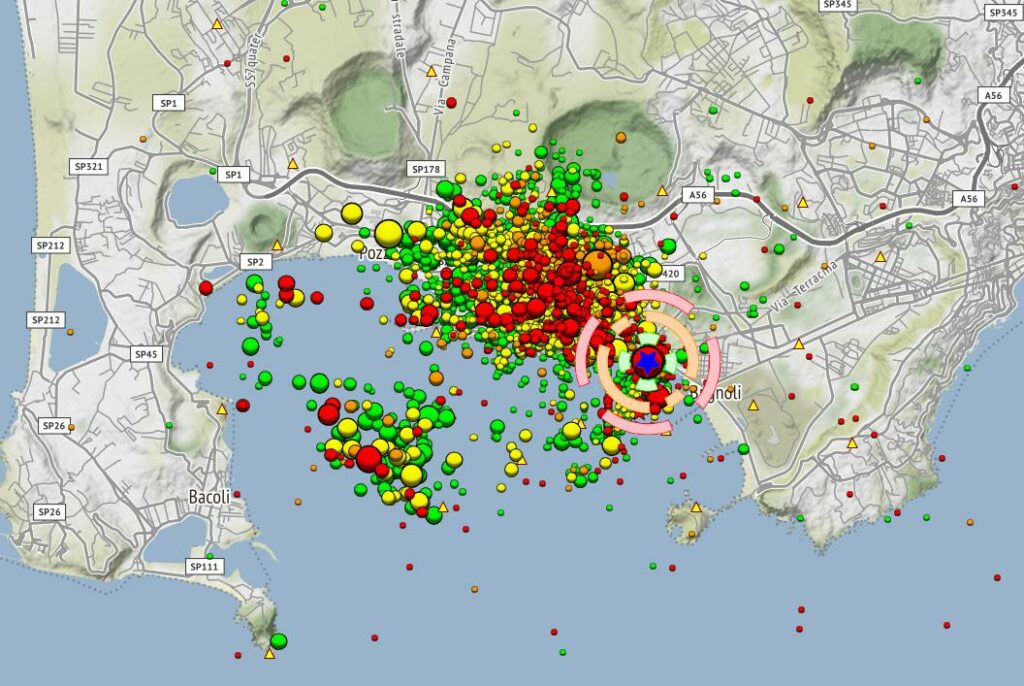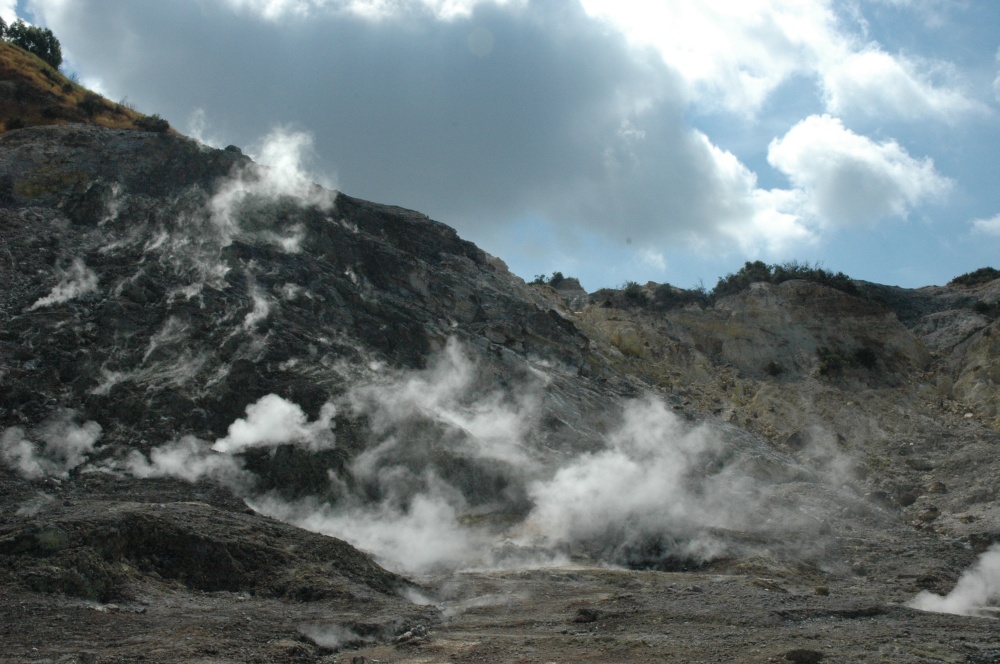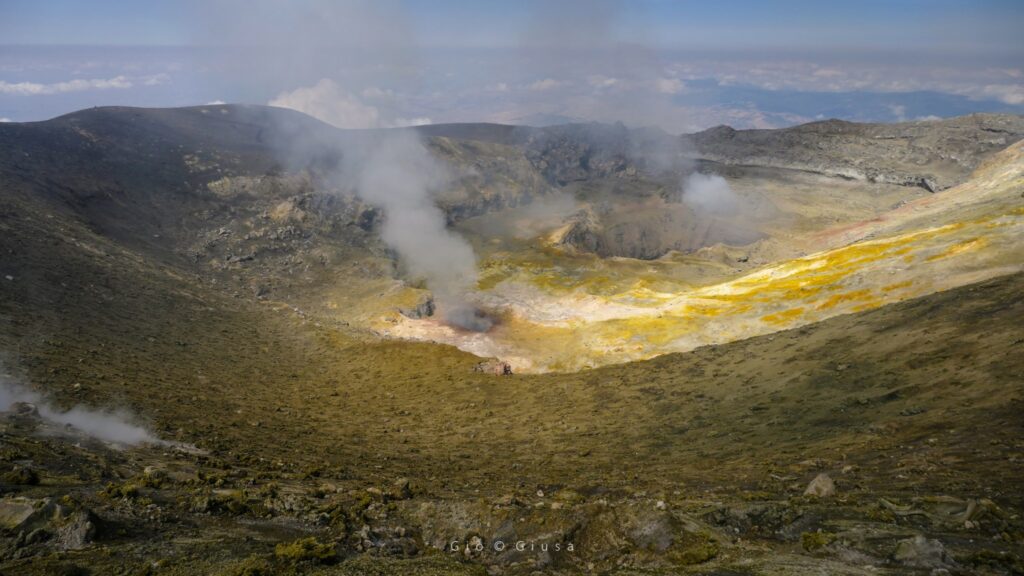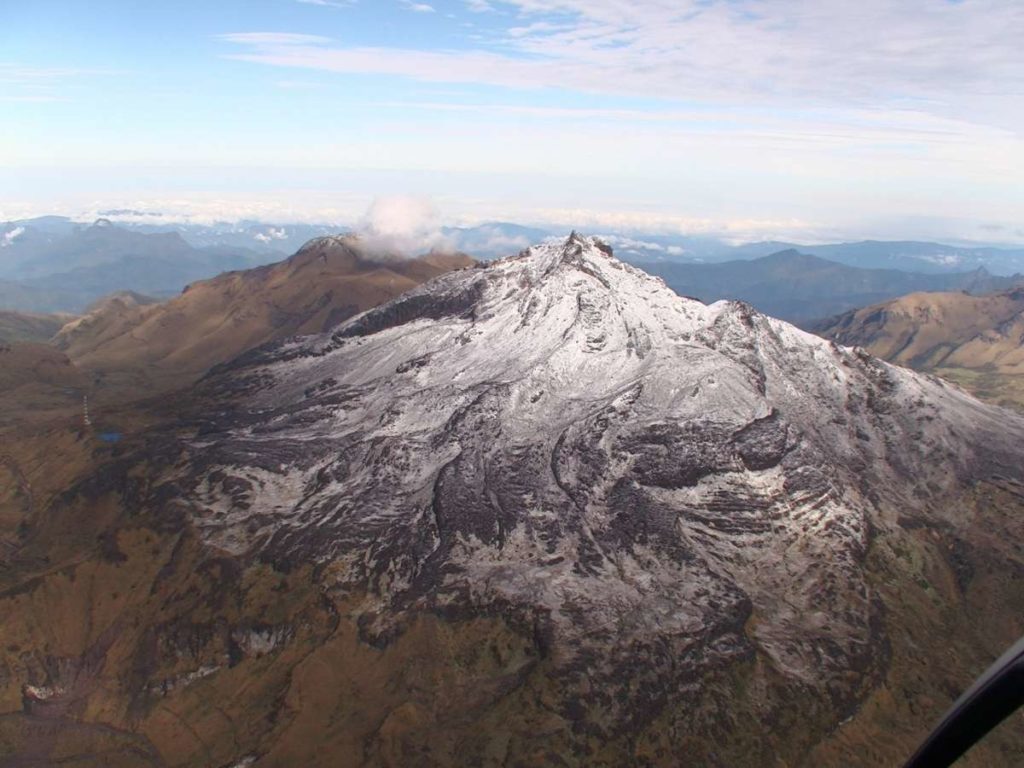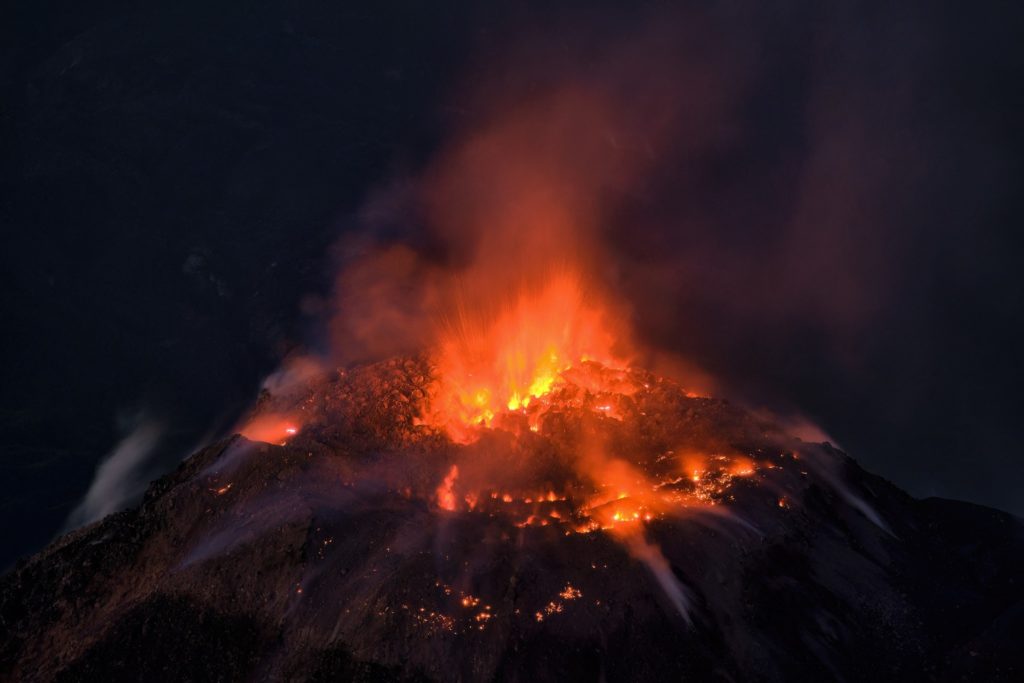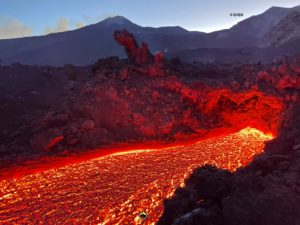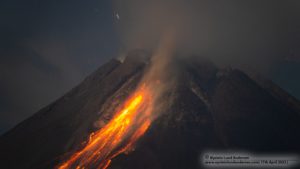September 27 , 2023 .
Italy , Campi Flegrei :
An earthquake of magnitude Md 4.2 occurred in the Campi Flegrei area.
September 27, 2023 at 01:35:34 (UTC), September 27, 2023, 03:35:34 (UTC +02:00) Italian time
with geographic coordinates (lat, lon) 40.8170, 14.1560 at a depth of 3 km.
SUMMARY STATEMENT OF ACTIVITY
In light of the monitoring data, it appears:
1) SISMOLOGY: In the week of September 18 to 24, 2023, in the Campi Flegrei area, 191 earthquakes of magnitude Md≥0.0 (Mdmax=3.2±0.3) were located.
2) DEFORMATIONS: From January 2023, the average value of the lifting speed in the maximum deformation zone is approximately 15±3 mm/month. In recent days there has been a possible increase in lifting speed, the real trend of which can be assessed using data from the coming weeks. The lift recorded at the RITE GNSS station is approximately 25 cm since January 2022.
3) GEOCHEMISTRY: There are no significant changes in the geochemical parameters monitored during the reference period. The temperature sensor installed in a fumarole emission 5 meters from the main Pisciarelli fumarole showed an average value of ~95°C, the condensation temperature of the fumarole fluid. The absence of liquid in the Pisciarelli basin remains.
SEISMOLOGY
In the week of September 18 to 24, 2023, in the Campi Flegrei area, 191 earthquakes of magnitude Md≥0.0 (Mdmax=3.2±0.3) were located.
59 earthquakes were recorded during 2 seismic swarms:
● the first, from 09:02 UTC on 09/22/2023, composed of 10 earthquakes of Md≥0.0 (Mdmax=3.2±0.3) occurring in the Solfatare zone;
● the second, from 9:15 p.m. UTC on 09/22/2023, composed of 49 earthquakes with Md≥0.0 (Mdmax=2.1±0.3) occurring in the Pozzuoli region.
Source : INGV
Photos : INGVStanley-goodspeed
Italy , Stromboli :
WEEKLY BULLETIN, from September 18, 2023 to September 24, 2023. (issue date September 26, 2023)
SUMMARY STATEMENT OF ACTIVITY
In light of the monitoring data, it appears:
1) VOLCANOLOGICAL OBSERVATIONS: During this period, normal Strombolian activity was observed with splashing activity in the North Crater area. The total hourly frequency of explosions fluctuated around high values (15-20 events/h). The intensity was low to medium in the North crater area and high in the South-Central area.
2) SISMOLOGY: The monitored seismological parameters do not show significant variations.
3) GROUND DEFORMATIONS: The island’s ground deformation monitoring networks did not show significant variations during the period studied.
4) GEOCHEMISTRY: SO2 flux at an average and increasing level.
The CO2 flow in the Pizzo area shows stable values at average levels.
The C/S ratio is at low values (C/S=2.9 as of 09/19/2023).
There is no update on the isotope ratio of dissolved helium in groundwater.
5) SATELLITE OBSERVATIONS: Thermal activity observed by satellite was generally at a moderate level.
VOLCANOLOGICAL OBSERVATIONS
In the observed period, the eruptive activity of Stromboli was characterized through the analysis of images recorded by the INGV-OE surveillance cameras at 190 m altitude (SCT and SCV), from Pizzo sopra la Fossa (SPT) and Punta dei Corvi (SPCT). The explosive activity was mainly produced by 3 eruptive vents located in the North crater area and by 3 vents located in the South-Central area.
Observations of explosive activity captured by surveillance cameras.
In the area of the North crater (N), characterized by two vents located in sector N1 and one in sector N2, explosive activity of varying intensity was observed from low (the erupting products reached a height of less than 80 m) to medium (height less than 150 m). The products emitted in the eruption were mainly coarse materials (bombs and lapilli), sometimes mixed with fine materials (ashes). Furthermore, continuous projection activity was observed in sector N1 which was intense on September 24. The average frequency of explosions oscillated between 8 and 12 events/h.
In the South-Central (CS) zone, sectors S1 and C did not show significant activity, while sector S2, characterized by three active vents (even simultaneously), mainly showed high intensity explosive activity (more than 150 m in height) with emission of coarse materials widely distributed along the external slopes of the crater terrace. The average frequency of explosions oscillated between 6 and 8 events/h
Source : INGV
Photo : Stromboli stati d’animo / Sebastiano Cannavo.
Italy / Sicily , Etna :
WEEKLY BULLETIN, from September 18, 2023 to September 24, 2023. (issue date September 26, 2023)
SUMMARY STATEMENT OF ACTIVITY
In light of the monitoring data, it appears:
1) VOLCANOLOGICAL OBSERVATIONS: Degassing activity mainly at the Bocca Nuova crater and the South-East crater.
2) SEISMOLOGY: Low seismic activity due to fracturing. Stationarity of volcanic tremor parameters.
3) INFRASOUND: Low infrasound activity.
4) GROUND DEFORMATIONS: Over the past week, ground deformation monitoring networks have not recorded any significant changes.
5) GEOCHEMISTRY: Medium-level SO2 flux.
The soil CO2 flux presents average values.
The partial pressure of CO2 dissolved in groundwater presents values included in seasonal variability.
There is no update on the helium isotope ratio.
6) SATELLITE OBSERVATIONS: Thermal activity observed by satellite was generally weak.
VOLCANOLOGICAL OBSERVATIONS
The monitoring of volcanic activity in the summit craters of Etna during the week was carried out thanks to the analysis of images from the network of surveillance cameras of the INGV – Catania Section, Osservatorio Etneo (INGV- OE) and through direct observations on earth (September 18).
The observations made during the inspection on September 18 highlighted that the degassing mainly affecting the South-East crater and Bocca Nuova continues and is unchanged compared to previous weeks.
Concerning the CSE, widespread degassing continues from the summit zone and from the upper part of the fracture present on its southwest flank.
Concerning Bocca Nuova, the intense degassing and temperatures remain almost unchanged compared to the last measurements. In particular, the degassing of the BN-1 vent is continuous and interspersed with strong explosions in conjunction with which temporary increases in the emission rate are observed; on the BN-2 mouth the degassing is of the pulsed type.
Regarding the Northeast crater, slight degassing was observed in an area of fumaroles along the Northwest wall, while the Voragine crater continues to be obstructed and inactive and no type of degassing occurs. was observed.
Source : INGV
Photo : Gio Giusa
Colombia , Chiles / Cerro Negro :
Weekly activity bulletin of the Chiles and Cerro Negro Volcanic Complex (CVCCN)
Regarding the monitoring of the activity of the CHILES AND CERRO NEGRO VOLCANOES, the MINISTRY OF MINES AND ENERGY, through the COLOMBIAN GEOLOGICAL SERVICE (SGC), reports that:
For the period from September 19 to 25, 2023, seismic activity continued to gradually decrease compared to the increase that began on August 5. However, significant levels persist, primarily in their occurrence, and the predominance of earthquakes associated with fracturing of rocks within the volcanic edifice continues. This type of earthquake was located mainly to the south of the Chiles volcano at distances of up to 4 km, with depths less than 7 km from its summit (4,700 m above sea level) and a maximum magnitude of 1 ,8. No felt earthquakes were reported. Deformation is maintained in several sectors of the volcanic edifice detected instrumentally by sensors installed in the volcanoes and also by satellite sensors.
The evolution of activity in the CVCCN continues based on the recorded manifestations of volcanic activity, which respond to processes derived from a complex interaction between the magmatic, hydrothermal and geological fault system of the area, which can trigger the occurrence of energetic earthquakes felt by residents in the CVCCN area of influence, as well as generate instability on slopes, landslides and structural damage to buildings, access roads, bridges, etc. . These are aspects that must continue to be taken into account by the authorities and the communities that reside in the zone of influence of these volcanoes.
The state of alert for volcanic activity remains at:
YELLOW ALERT: Active volcano with changes in the behavior of the base level of monitored parameters and other manifestations.
Source : SGC
Photo : hablemosdevolcanes.com
Guatemala , Santiaguito :
Weather conditions: Clear weather
Wind: East
Precipitation: 22.4 mm.
Activity:
Constant degassing on the Caliente Dome. Seismic stations continue to record small to moderate explosions that generate avalanches in all directions and a column of gas and ash that reaches 3,200 meters above sea level (10,498 feet) and disperses toward the West and the South-West. This can cause fine ash particles to fall and a foggy environment near the volcano. During the night and early morning, constant incandescence was observed in the upper part of the dome. Strong avalanches and audible noises can be generated several kilometers from the volcanic edifice. The occurrence of block and ash flows of moderate to strong characteristics is not excluded, as well as possible pyroclastic flows over long distances in different directions.
Source : Insivumeh
Photo : Thomas Spinner via FB .


